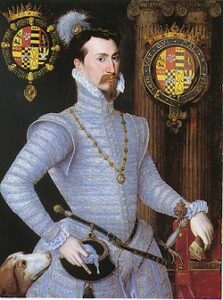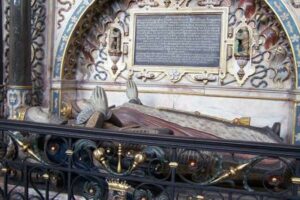
In her book “Elizabeth I”1, Anne Somerset writes of how Leicester’s health had been deteriorating for some time and that at the end of August 1588 Leicester set off for Buxton, Derbyshire, which was known for its healing baths of spa water. It was en-route to Buxton, at Rycote near Reading, a house which he had visited with Elizabeth, that Leicester wrote his last letter to his beloved Bess on the 29th August:-
“I most humbly beseech your Majesty to pardon your poor old servant to be thus bold in sending to know how my gracious lady doth, and what ease of her late pains she finds, being the chiefest thing in this world I do pray for, for her to have good health and long life. For my own poor case, I continue still your medicine and find that (it) amends much better than with any other thing that hath been given me. Thus hoping to find perfect cure at the bath, with the continuance of my wonted prayer for your Majesty’s most happy preservation, I humbly kiss your foot. From your old lodging at Rycote, this Thursday morning, ready to take on my Journey, by your Majesty’s most faithful and obedient servant,
R. Leicester
Even as I had writ thus much, I received Your Majesty’s token by Young Tracey.”2
This was the letter that Elizabeth I inscribed “His Last Letter” and treasured, keeping it in a box by her bedside where it was found after her death.
After writing this letter, Leicester continued his journey, stopping at Combury Park, near Woodstock in Oxfordshire, where his condition deteriorated until, at 4am on the 4th September, he passed away. He was buried in the Beauchamp Chapel of the Collegiate Church of St Mary’s in Warwick, the same place as his son, Robert Dudley, Lord Denbigh, who died in 1584 aged three. Leicester’s wife, Lettice (née Knollys), was buried alongside him after her death in 1634.
Elizabeth I was devastated by the death of the man she referred to as her “Eyes” or as “Sweet Robin”. They had known each other since childhood and I believe that he was the love of her life. Anne Somerset quotes an informant of Mendoza as reporting that “She was so grieved that for some days she shut herself in her chamber alone, and refused to speak to anyone until the Treasurer and other Councillors had the doors broken open and entered to see her”3 and Sir Francis Walsingham reported on the 7th September that it was impossible to do business with Elizabeth by “reason that she will not suffer anybody to [have] access unto her, being very much grieved with the death of the Lord Steward [Leicester].”4 Two months later, in November 1588, Elizabeth was described as “much aged and spent, and very melancholy” – Leicester’s death had hit her hard.
Jeane Westin, author of “His Last Letter: Elizabeth I and the Earl of Leicester”, brought me to tears with her moving scene in her prologue, when Elizabeth finds out that Leicester is dead:-
“She opened her mouth to shout down his lie, but at that moment came a great boom of cannon from the Tower and what the queen howled was neither heard nor understood by anyone in the presence chamber, least by herself. It was a cry of denial from the deepest well of her heart…
… She said something, but it was lost in a swift-moving red pain that filled her and became a sound… a name… Robin… my long love. How could I have forgotten you for a moment, even in my greatest triumph, our greatest triumph?
“Majesty, you should come away to your chambers. I would not have the court see you thus. A queen does not-”
“Does not!” she shrieked at her faithful advisor of thirty years and more. “Does not feel agony, does not… ” She lost the words spilling from her heart, if she had words instead of shrieks of disbelief. It could not be. Not Robin. He had promised never to leave her.”5
A beautifully written scene and it is impossible not to be moved by it.
Elizabeth did manage to pick herself up and do her duty as queen, but it is obvious that she never got over Leicester’s death. RIP Robert Dudley, Earl of Leicester.

Notes and Sources
- Elizabeth I, Anne Somerset, p595-596
- His Last Letter, Jeane Westin, p360, Author’s Historical Note
- Somerset, p596
- Ibid.
- Westin, p9









Thank you, Claire. I came to tears writing that scene. Her pain was so real to me.
Jeane Westin
Robert Dudley was so much more than just the great favourite of Queen Elizabeth.
His teacher Roger Ascam said he had a great talent for languages and writing. He was a brilliant horseman – Queen Elizabeth made him her Master of the Horse, a position he held until a year before his death, when his stepson Robert Devereux, Earl of Essex succeeded him. He also was a great patron of the arts. The Queen used to call him her eyes and he was loyal to her until his death. Rest in peace Robert Dudley.
IClaire, that portrait you have of Robert is my favurite – I believe it is the Waddesdon Portrait.
Claire, I see what you mean. I still have tears in my eyes as I type this.
Good old Dudley! I still feel he was a decent enough man. When you read his letters – like those to Cecil – he comes over as caring and courteous. It ‘s easy to look at that portrait and think the worst – arrogant etc, self-centred. Maybe he was all of these. But Elizabeth had good judgement in her choice of friends. She could not have been wrong about him for so many years. She would not have cared for him unless there were genuine qualities there. He has to be an important figure in English history for the role he played in E’s life.
RIP
I have just finished reading His Last Letter by Jeane Westin. I have to say it was a wonderful read. I was in tears several times. I would heartily recommend it to anybody who is as fascinated as I am by the Robert and Elizabeth story.
I volunteer for Historic Royal Palaces and I often work at Kew Palace (was there today in fact) There is a Tudor undercroft, which is thought to have been the home of a Tudor Courtier. There is a possibility (by no means certain) that it might have been the home of Robert Dudley. I have certainly read that he did have property in the Kew area. If it had been his home there is also a strong possibility that Queen Elizabeth could have visited him there. Of course, Kew, National Archives is I believe where the original copy of Robert’s last letter is kept.
Hi Carol,
It must be great to volunteer at the palaces and spend lots of time there, magical! That’s interesting about the Kew property, I’ll look out for mention of it next time I’m going through archives. My father was a student in Kenilworth and says that the old property he lodged in was supposed to have had something to do with Robert Dudley, so I’ll have to look into that too!
Robert had a house at Kew which Elizabeth gave him in 1559. He passed the days after Amy’s death there, writing to Cecil and having many lords and his family as mourning visitors. According to a very hostile reporter (who held a personal grudge against them but did not see or know any of them personally) they were all weeping, with “much hypocrisy used”.
Hi Claire
It certainly is a great privilege to be able to volunteer in such wonderful places as Hampton Court Palace, Tower of London, Kensington Palace and Kew Palace. History has been a great love of mine sinch childhood so it is a real pleasure to have the opportunity to work in places where so much famous history actually took place.
I believe the house where Robert Dudley lived iat Kew was called The Dairy House. It would be fascinating to find out more about it. If it is not at the Kew Palace site, it certainly must have been close by. I really must get to Kenlworth, to see the gardens there. I would also like very much to see where Robert is buried in The Beauchamp Chapel,St Mary’s Church in Warwick.
That was a wonderful scene and a lovely book. I, too, am sad every time I see Dudley pass away–like in the movies and TV and in books. I hate to lose him–I almost feel he is mine in some strange way or maybe just imagine what sucha loss would be like. I agree that Elizabeth never recovered fully from his death.
I have just finished reading The Virgins Lover by phillipa Gregory and everytime I read the love story between Elizabeth and Robert Dudley I feel really saddened that it could never be. The book in parts makes painful reading because you know what the outcome is and what happened to Amy Robsart because it is a true story. I never get tired of reading about Elizabeth and Tudor England. I am a history nut, I can’t get enough of it.